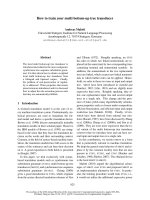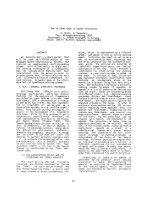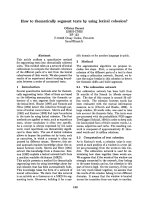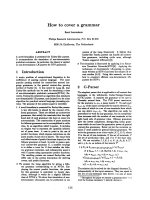Báo cáo y học: "How to prevent leaky vessels during reperfusion? Just keep that glycocalyx sealant in place" pps
Bạn đang xem bản rút gọn của tài liệu. Xem và tải ngay bản đầy đủ của tài liệu tại đây (40.03 KB, 2 trang )
Page 1 of 2
(page number not for citation purposes)
Available online />Abstract
Myocardial edema is a hallmark of ischemia-reperfusion-related
cardiac injury. Ischemia-reperfusion has been shown to result in
degradation of the endothelial glycocalyx. The glycocalyx is the gel-
like mesh of polysaccharide structures and absorped plasma
proteins on the luminal side of the vasculature, and in the past
decade has been shown to play an important role in protection of
the vessel wall, including its barrier properties. Prevention of
glycocalyx loss or restoration of a damaged glycocalyx may be a
promising therapeutic target during clinical procedures involving
ischemia-reperfusion.
Prevention of coronary fluid leakage to reduce myocardial
damage during ischemia-reperfusion-related clinical proce-
dures constitutes an important therapeutic challenge. In the
previous issue of Critical Care, Bruegger and colleagues
presented data indicating that anticipation of glycocalyx loss
may alleviate fluid leakage and edema formation in hearts
undergoing occlusion and subsequent reperfusion [1].
The glycocalyx: protector of endothelial
function
The glycocalyx is a negatively charged, gel-like mesh of
polysaccharide structures and absorped plasma proteins on
the luminal side of all blood vessels, and in the past decade
has been shown to play an important role in protection of the
vessel wall [2]. Major insight into the functional properties of
the glycocalyx has been provided in past decades by intravital
microscopic studies of striated muscle microcirculation in
rodents. These studies showed that the glycocalyx
constitutes a voluminous intravascular barrier for flowing
blood and macromolecules [3], and that enzymatic glycocalyx
degradation is associated with an increased adhesiveness of
the endothelium for platelets and leucocytes [4] and with an
impaired nitric oxide (NO)-mediated shear-dependent vaso-
dilation of arterioles [5]. In addition, glycocalyx treatment in
isolated hearts was demonstrated to result in an increased
fluid leakage [6,7], underlying the contribution of the glyco-
calyx to the vascular permeability barrier in conjunction with
the endothelial cells (double barrier concept [1,7]).
More specific experimental data have been provided
indicating that it is the colloid osmotic pressure difference
across the glycocalyx rather than the pressure difference
between the interstitial space and plasma that opposes fluid
filtration in the Starling balance [8]. Protection of the
glycocalyx may therefore be an essential facet when
considering treatment of excessive fluid loss in clinical
practice.
Glycocalyx degradation during
ischemia-reperfusion
Using a highly standardized protocol of ischemia-reperfusion,
Bruegger and colleagues studied the effect of exogenous NO
administration on fluid leakage and glycocalyx damage in
Krebs–Henseleit-buffered isolated guinea pig hearts, a model
this group has been using for many years [1,7,9]. In the
model, dynamic changes in fluid filtration are measured by
repeated collection of the transudate appearing at the
epicardial surface and dripping off the apex of the heart.
Bruegger and colleagues demonstrated that the increase in
fluid filtration and subsequent edema formation after
ischemia-reperfusion was completely abolished in the hearts
when exogenous NO was administered to the perfusate [1].
The reduction in fluid leakage was accompanied by a 20% to
40% reduction in cumulative heparan sulfate release in the
coronary venous effluent, suggesting that NO partially
prevented shedding of these glycosaminoglycans from the
Commentary
How to prevent leaky vessels during reperfusion?
Just keep that glycocalyx sealant in place!
Jurgen WGE VanTeeffelen
Department of Physiology, Cardiovascular Research Institute Maastricht, Maastricht University, UNS 50, 6229 ER Maastricht, PO Box 616,
6200 MD Maastricht, the Netherlands
Corresponding author: Jurgen WGE VanTeeffelen,
Published: 15 July 2008 Critical Care 2008, 12:167 (doi:10.1186/cc6939)
This article is online at />© 2008 BioMed Central Ltd
See related research by Bruegger et al., />NO = nitric oxide.
Page 2 of 2
(page number not for citation purposes)
Critical Care Vol 12 No 4 VanTeeffelen
glycocalyx. This prevention was also evidenced by a modest
preservation of glycocalyx structures on the vascular endothe-
lium in the microscopic images obtained after the experiment.
The authors hypothesize that the action of NO on glycocalyx
protection against shedding was due to scavenging of
oxygen-derived free radicals liberated upon reoxygenation [1].
Indeed, increased oxidative stress has been demonstrated to
be the common denominator underlying glycocalyx loss during
atherogenic, inflammatory, and hyperglycemic conditions [10-
14]. With respect to the source of free radicals involved in
glycocalyx degradation during ischemia-reperfusion, Rubio-
Gayosso and colleagues provided evidence that, at least in
the cremaster muscle, the oxygen radical-producing enzyme
xanthine oxidoreductase was involved [13]. This enzyme has
a heparin-binding domain and therefore is probably asso-
ciated with heparan sulfate glycosaminoglycans within the
glycocalyx, which would explain the increased shedding of
heparan sulfates during ischemia-reperfusion.
Glycocalyx protection: therapeutic opportunities
Given the pivotal role of the glycocalyx in vascular wall
homeostasis, restoration of a damaged glycocalyx may be a
promising therapeutic target both in an acute critical care
setting as well as in the treatment of chronic vascular
disease. Free radical scavengers or pharmacological blockers
of radical production are useful to diminish the oxygen radical
stress on the glycocalyx [11], while drugs that can increase
glycocalyx production or prevent proteolytic activity may
prevent or restore induced glycocalyx loss [9,12]. Finally,
infusion of glycocalyx components to reconstitute lost glyco-
calyx might be useful during clinical interventions.
Infusion of hyaluronic acid glycosaminoglycans before or
shortly after the initiation of cremaster tissue reperfusion
almost fully restored the impaired barrier properties of the
glycocalyx in the study of Rubio-Gassayo and colleagues
[13]. In another cremaster study, addition of heparan sulfates
and heparin was demonstrated to alleviate venular leucocyte
adhesion associated with glycocalyx damage; intravital
microscopy illustrated that the infused components actually
attached to the venular luminal surface [4]. Heparin adminis-
tration also reduced the detrimental effect of ischemia-
reperfusion injury on glycocalyx integrity in the study of Rubio-
Gassayo and colleagues [13]; although this was suggested
to be due to a heparin-induced displacement of xanthine
oxidoreductase from the glycocalyx, it is probable that the
beneficial effect of heparin actually reflected some recon-
stitution of the glycocalyx.
Worthy of note is the observation that administration of
heparin in control, nonchallenged, mice was associated with
an impaired shear-dependent NO-mediated arteriolar dilation
and loss of glycocalyx barrier properties [5]. This observation
suggests that heparin can have an adverse effect on the
integrity of the glycocalyx in the healthy situation – potentially
by the displacement of heparan sulfate-bound proteins. The
paper by Bruegger and colleagues in the previous issue of
Critical Care clearly warrants further clinical attention for
glycocalyx protection as a therapeutic target.
Competing interests
The author declares that they have no competing interests.
Acknowledgements
The author is supported by research grants from the Netherlands Heart
Foundation (2005T073 and 2003B181) and from the Dutch Diabetes
Research Foundation (2006.00.027).
References
1. Bruegger D, Rehm M, Jacob M, Chappell D, Stoeckelhuber M,
Welsch U, Conzen P, Becker BF: Exogenous nitric oxide
requires an endothelial glycocalyx to prevent postischemic
coronary vascular leak in guinea pig hearts. Crit Care 2008,
12:R73.
2. Van Teeffelen JW, Brands J, Stroes ES, Vink H: Endothelial gly-
cocalyx: sweet shield of blood vessels. Trends Cardiovasc Med
2007, 17:101-105.
3. Vink H, Duling BR: Identification of distinct luminal domains for
macromolecules, erythrocytes, and leukocytes within mam-
malian capillaries. Circ Res 1996, 79:581-589.
4. Constantinescu AA, Vink H, Spaan JA: Endothelial cell glycoca-
lyx modulates immobilization of leukocytes at the endothelial
surface. Arterioscler Thromb Vasc Biol 2003, 23:1541-1547.
5. VanTeeffelen JW, Brands J, Jansen C, Spaan JA, Vink H: Heparin
impairs glycocalyx barrier properties and attenuates shear
dependent vasodilation in mice. Hypertension 2007, 50:261-
267.
6. van den Berg BM, Vink H, Spaan JA: The endothelial glycocalyx
protects against myocardial edema. Circ Res 2003, 92:592-
594.
7. Rehm M, Zahler S, Lotsch M, Welsch U, Conzen P, Jacob M,
Becker BF: Endothelial glycocalyx as an additional barrier
determining extravasation of 6% hydroxyethyl starch or 5%
albumin solutions in the coronary vascular bed. Anesthesiol-
ogy 2004, 100:1211-1223.
8. Hu X, Adamson RH, Liu B, Curry FE, Weinbaum S: Starling
forces that oppose filtration after tissue oncotic pressure is
increased. Am J Physiol 2000, 279:H1724-H1736.
9. Chappell D, Jacob M, Hofmann-Kiefer K, Bruegger D, Rehm M,
Conzen P, Welsch U, Becker BF: Hydrocortisone preserves the
vascular barrier by protecting the endothelial glycocalyx.
Anesthesiology 2007, 107:776-784.
10. Mulivor AW, Lipowsky HH: Inflammation- and ischemia-
induced shedding of venular glycocalyx. Am J Physiol 2004,
286:H1672-H1680.
11. Nieuwdorp M, van Haeften TW, Gouverneur MC, Mooij HL, van
Lieshout MH, Levi M, Meijers JC, Holleman F, Hoekstra JB, Vink H,
Kastelein JJ, Stroes ES: Loss of endothelial glycocalyx during
acute hyperglycemia coincides with endothelial dysfunction
and coagulation activation in vivo. Diabetes 2006, 55:480-486.
12. Nieuwdorp M, Meuwese MC, Mooij HL, van Lieshout MH, Hayden
A, Levi M, Meijers JC, Ince C, Kastelein JJ, Vink H, Stroes ES:
Tumor necrosis factor-alpha inhibition protects against
endotoxin-induced endothelial glycocalyx perturbation.
Atherosclerosis 2008, 12. Epub ahead of print. [doi: 10.1016/
j.atherosclerosis.2008.03.024].
13. Rubio-Gayosso I, Platts SH, Duling BR: Reactive oxygen
species mediate modification of glycocalyx during ischemia-
reperfusion injury. Am J Physiol 2006, 290:H2247-H2256.
14. Vink H, Constantinescu AA, Spaan JA: Oxidized lipoproteins
degrade the endothelial surface layer: implications for
platelet–endothelial cell adhesion. Circulation 2000, 101:
1500-1502.









